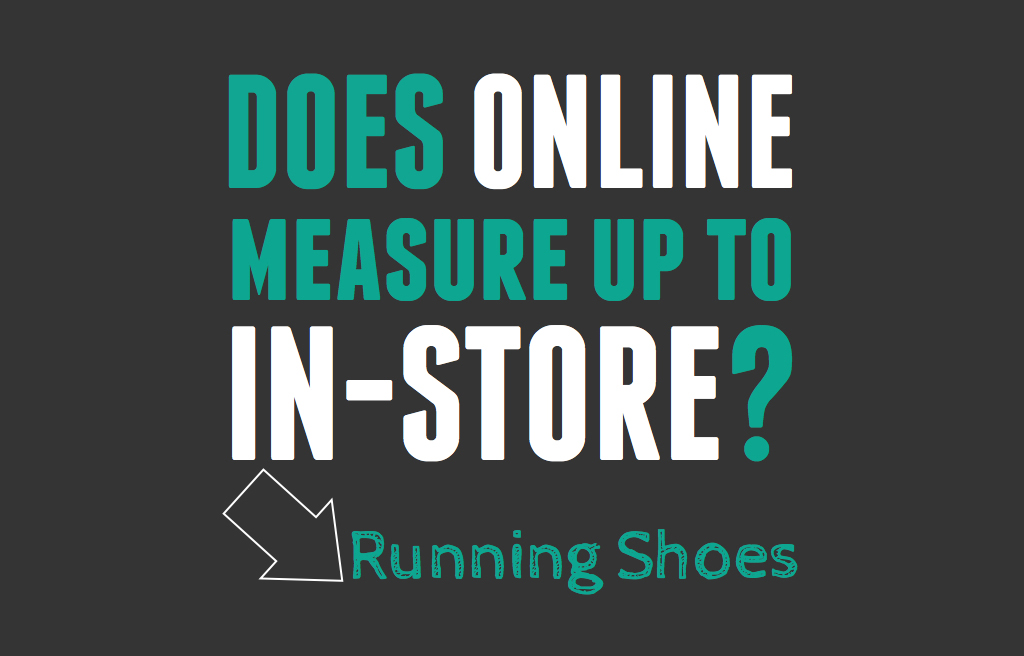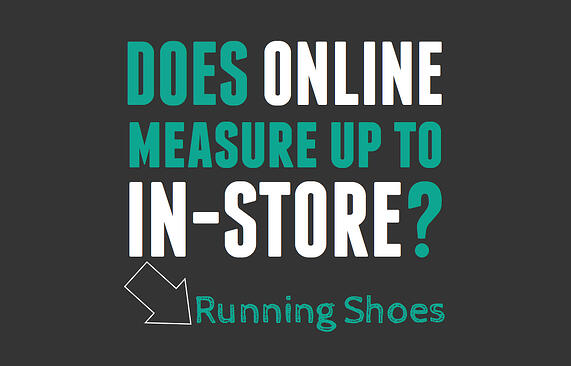
From music to books to expensive digital cameras, consumers have become quite comfortable buying a variety of items online. But there are some purchases, like running shoes, that have traditionally required more of a personal investment. We wondered: Do websites provide enough information for us to comfortably buy running shoes online - without trying them on? And, if so, is that even a smart thing to do?
To answer this, I spoke with a running shoe expert and manager of Fleet Feet Sports. I then picked five of the top running shoe manufacturers, deconstructed their online product pages and analyzed how well online can replace the in-store experience.
The key importance of the in-store experience
I started off by speaking with Kyle, the manager of the Fleet Feet Sports in Marlton, New Jersey. When I asked him if he ever uses the Internet to search for shoes, he answered immediately: “All the time.” But when I asked if he’s ever purchased shoes solely after an online consultation, the answer was a resounding no.
While the trying-on process is generally important in any shoe purchase, he explained that there can be negative physical consequences for an athlete wearing a misfit shoe. Thus, running shoe specialists are trained to know not only about the shoes themselves, but also how your individual foot fits into the shoe.
The availability of product specs online, specialists say, makes consumers think they’re all experts. But while consumers are encouraged to thoroughly do their research, experts are convinced that nothing replicates the physical experience of trying on a shoe with in-store consultation.
Even if a new shoe has a similar fit to one you’ve previously been fitted for, issues since that initial fitting – newly acquired habits, bunions, etc. – might require different specifications that can be determined in-store.
Does the online experience measure up yet?
But people are clearly buying a lot of running shoes online, a truth that running shoe specialists are begrudgingly starting to accept. I checked out a few websites myself and, on first glance, they seemed quite comprehensive.
I asked which details change most dramatically between otherwise almost identical shoes. Kyle gave me three to look at: weight, cushioning, and heel-to-toe drop. Rather than “grade” a website based on how many of these characteristics it features, I simply used these details to help me see how product details are organized.
I picked five of the top running shoe brands in the country: Asics, Brooks, New Balance, Nike, and Saucony. I was immediately struck by how difficult it was to pick out these three details across just five websites. Large graphics, tabs, frames, and video make for aesthetically pleasing sites, but it also means that there’s A LOT of places to look for info.
The Nike site, for instance, boasts a beautiful showcase frame at the top of the page for images of each shoe from all angles. Details about the shoe, however, are buried in paragraphs of text you scroll through down below. Across websites, I found information about cushioning in text, video, and graphic mediums. And heel-to-toe drop was simply missing from three sites.
In general, each site was a brand-new experience – I wasn’t quite sure where on the page to start looking first.

How to fit your running shoes
When a running shoe specialist fits you for a shoe, he or she generally asks a few basic questions, gives you a few options, lets you try them on, and takes a close look at how your foot fits in each shoe.
To completely replicate the in-store experience, websites must come up with some kind of comparable alternative to this process. Asics, New Balance, and Nike impart minimal counsel for consumers in this regard. They provide basic sizing and width guides, but not much else. “This shoe runs true to size. Order your regular athletic shoe size,” reads the New Balance site simply, in small print.
Saucony and Brooks, on the other hand, both utilize Shoefitr, an application that estimates how well a particular shoe will fit your foot, based on the size and model of a shoe you currently wear. With thermal diagrams to estimate fit at each part of the foot, it’s very helpful software. While it still doesn’t take into account all the unique features of each individual foot, it gets incredibly close.
Brooks goes one step further. With the Shoe Advisor application, consumers can input their gender, foot width, weight, activity, and pronation (“How do you roll? We don’t mean on a Saturday night,” the explanation says cheekily) and receive two recommendations for Brooks shoes that best fit their answers.
Factoring in outside opinion
There is probably some contention over where outside opinion factors into the equation. To Kyle, consumer reviews help spur or reduce interest before trying on the shoe, but it’s ultimately one-on-one consultation at the end of the process that seals the deal. For others, reviews are all the outside perspective they need before hitting the “Add to Cart” button. So can online reviews give consumers as much confidence as an expert’s endorsement?
All five of these websites have rather aesthetically minimalist consumer review sections, but they serve their purpose. In addition to leaving ample room for comments, they all boast some sort of reviewer profile, be it Nike’s two-question athletic activity summary or Brooks’ preset series of pros, cons, and individual fit answer choices.
While running shoe specialists offer advice based on a blend of past consumer experiences, consumer reviews online individually lay out these experiences (ideally) from the mouths of each user. With social shopping now becoming popular across a number of industries, personal recommendations go a long way.
But the value of these reviews also vary from shoe to shoe, depending on how many consumers have chosen to submit comments. If a shoe has no reviews, the comment section has little use.
And even if there is a lot of consumer feedback for a particular shoe, one must take into consideration what percentage of the demographic is taking time to fill out a review. (The happy folk? The disappointed folk? The running enthusiasts?) Consumer reviews must be taken with a grain of salt. So too, though, must the consultation of one specialist.
Conclusion
When it comes to answering the question, “CAN we buy this online?” the answer is yes.
There are enough resources at consumer disposal – large images, lots of product specs, reviews, videos, and, if you’re lucky, in-depth fitting guides – for one to generally feel quite confident about making a purchase.
But if companies want to truly replicate the in-store experience, they’re going to have to try harder. Without any sort of standardization of product details on display, comparing specific shoe specs across websites is not always an easy task.
Companies are also going to have to make their online fit guides more comprehensive. While no application (yet) can digitally map out shoe fit to the individual foot, software like Shoefitr comes close – and can be even more effective if more widely adopted.
While online already provides much of the shopping experience, it is blatantly missing the personal attention given in-store. When it comes to the second part of our question – “Is it SMART to buy this online?” – the answer depends on the individual. Running shoe experts say no, on the grounds that no online consultation can fully tailor to an individual situation, nor predict the potential consequences from a misfit shoe.
But with technology changing by the second, and E-commerce an increasingly hot buzzword, online poses a serious threat of converting running shoe shoppers for good – especially those who don’t take the experts’ word seriously.
Written by: Emily Saka
Recent Posts
Summit Spotlight: Salsify Leaders Share How To Advance to the Next Decade of the Digital Shelf
Omnichannel Strategy: Here Are the Top 3 Drivers of Omnichannel Profitability
Digital-Influenced Retail Will Describe 70% of U.S. Sales by 2027 — What Does This Mean for Brands?
Subscribe to the Below the Fold Newsletter
Standing out on the digital shelf starts with access to the latest industry content. Subscribe to Below the Fold, our monthly content newsletter, and join other commerce leaders.



